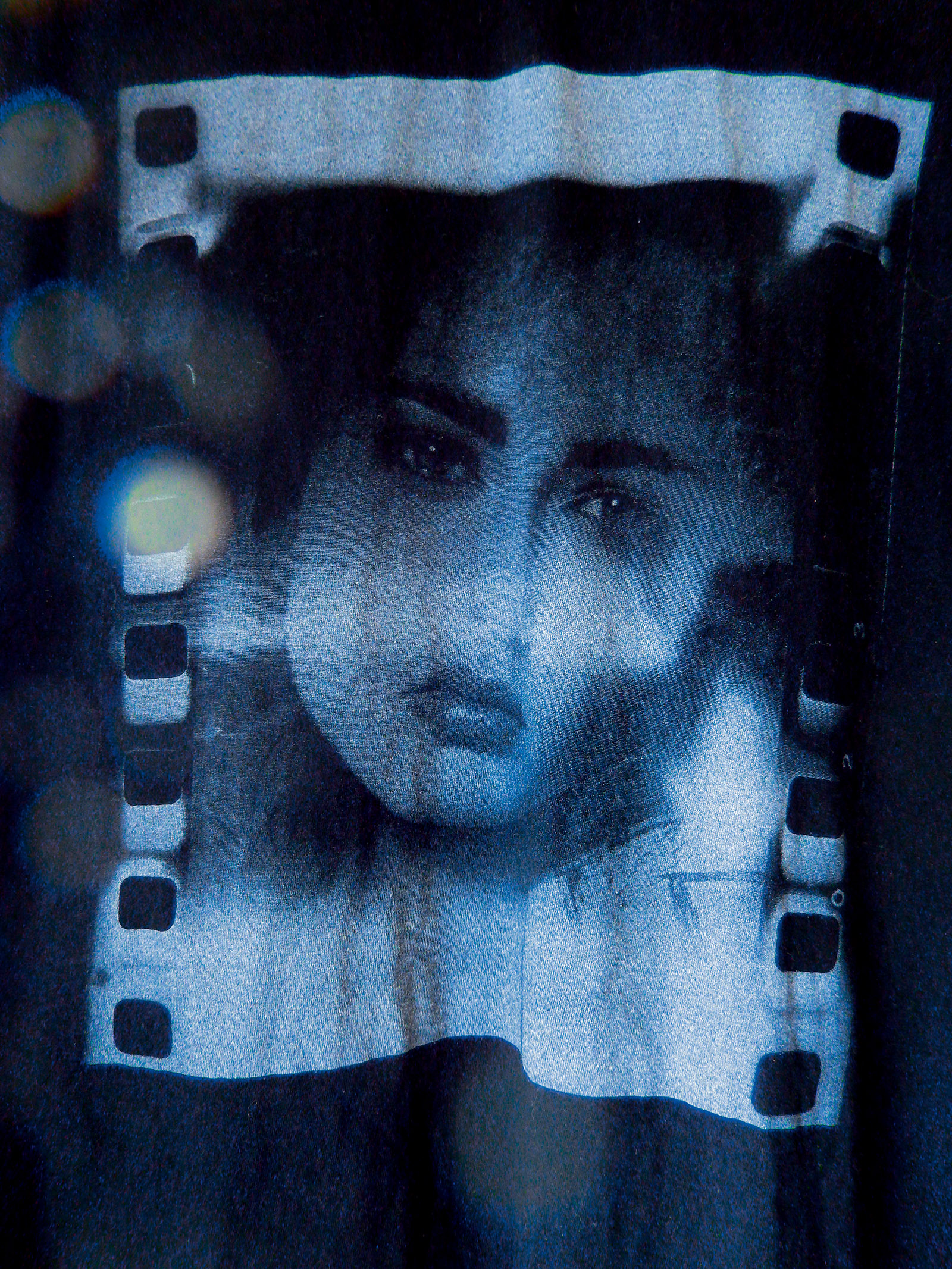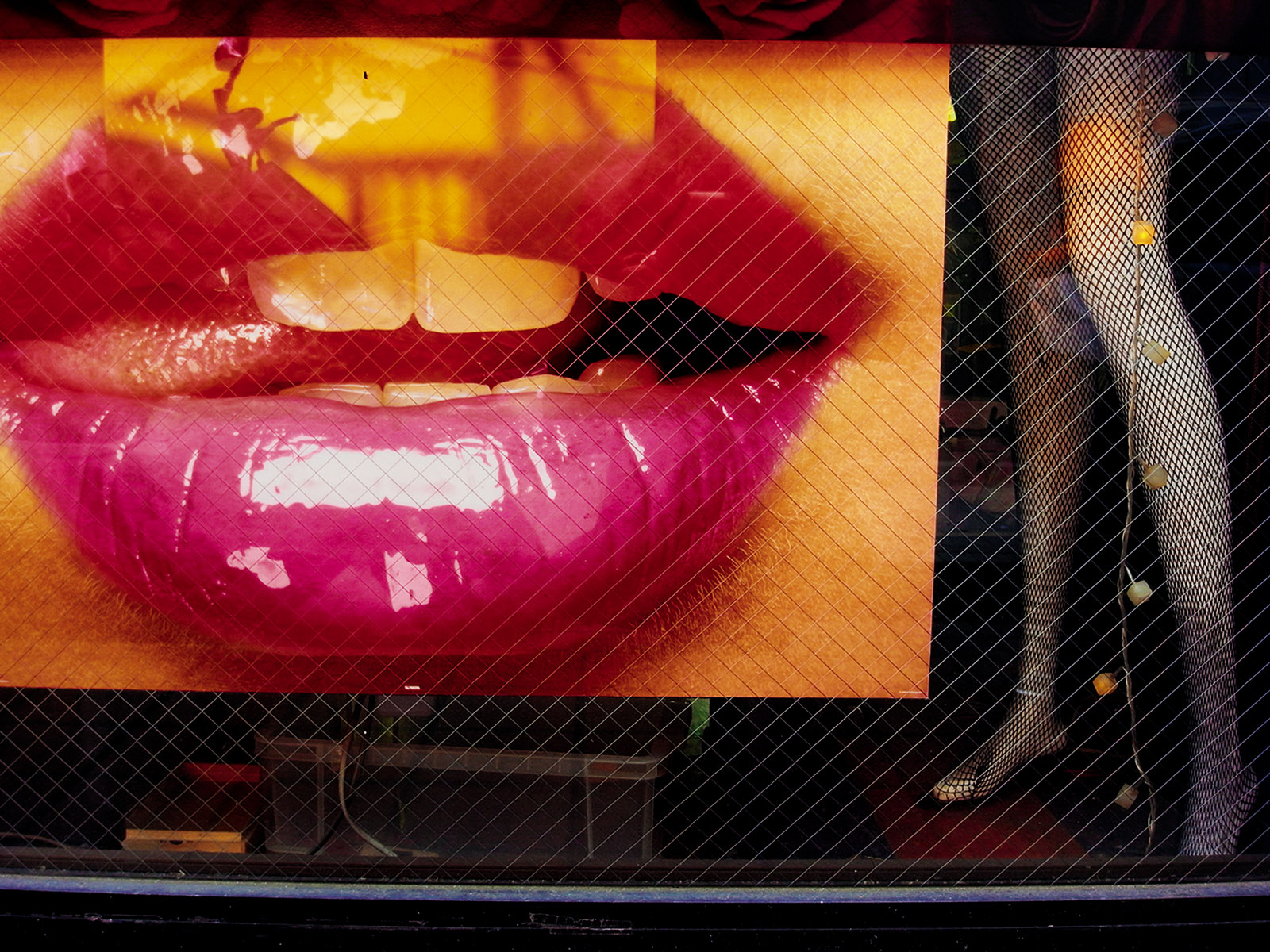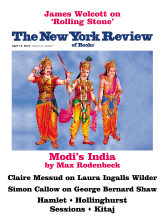One of Moriyama Daidō’s most famous black-and-white photographs is of a stray dog, a bit wolfish, with matted hair, looking back into the camera watchfully, with a hint of aggression. He took the picture in 1971 in Misawa, home to a large US Air Force base, in the northeast of Japan. Moriyama has described this dog picture as a kind of self-portrait:
I wander around, glare at things, and bark from time to time…. Something there is close to how I look at things and to how I probably appear when I’m wandering. Having become a photographer, I always sensed that I have strayed.
Most people can come up with a decent photograph once in a while, which will look like millions of other photographs. Only the greatest photographers can be easily identified by a unique personal style. Moriyama is one of them. There are some recurring images, in different settings, in color and black-and-white, many of which appear in the three books under review: the grainy close-up of a torn pornographic film poster on a peeling wall; a woman’s legs in mesh tights picked out in a crowded street; a filth-strewn back alley crisscrossed with electric wires; a blown-up newspaper photograph; net curtains in a cheap hotel room; a dilapidated old bar with broken neon lights. Moriyama has an exact eye for the textures of urban life, often decaying, ephemeral, sadly alluring in their temporary shine. In his photographs even inanimate objects, such as pipelines or motorcycle engines, have a vaguely anthropomorphic air about them; they look sexy.
The art of the ephemeral, the melancholy of the fleeting moment, has a long history in Japanese art, but Moriyama has focused his sensibility not on such traditional clichés as the cherry blossom (although in fact he has done that too), but on the commercialized, Americanized, plastic-fantastic, sometimes violent, sometimes erotic surfaces of the modern city. Christopher Isherwood once said about Los Angeles, the city he made his own:
What was there, on this shore, a hundred years ago? Practically nothing. And which, of all these flimsy structures, will be standing a hundred years from now? Probably not a single one. Well, I like that thought. It is bracingly realistic. In such surroundings, it is easier to remember and accept the fact that you won’t be here, either.
The urban sprawl of Southern California, with its billboards, strip malls, and pastiche architecture offering dreams of other places, has been a kind of model for postwar Japanese cities, which often look like much denser versions of Los Angeles. Not only was Tokyo almost entirely destroyed twice in the twentieth century—the first time by a firestorm following the terrible earthquake of 1923 and the second time by B-29 bombers in 1945, when much of the city went up in flames once more—but after the war it was rebuilt very fast in a nationwide scramble for economic revival under American tutelage. To find elements of traditional beauty in modern Tokyo or Osaka, where Moriyama grew up, you have to look very carefully around all the modern mess. The art of Moriyama is to ignore those pretty bits and make the messy look beautiful.
Moriyama is not the only artist to work that vein. Reveling in the dirt of postwar urban life has been the mark of many Japanese filmmakers, dancers, novelists, manga artists, and photographers. Moriyama has collaborated with several of them, such as the playwright, poet, and film director Terayama Shūji and the Butoh dancer Hijikata Tatsumi, both of whom used the Tokyo streets as the backdrop of their performances, which were photographed in the 1960s by the young Moriyama.
A huge influence on Moriyama in those days was the photographer Tōmatsu Shōmei, who was eight years older (Moriyama was born in 1938). Tōmatsu’s attitude toward what the Americans had wrought in Japan, during the military occupation but also during the period that followed, when American-style commercial culture wiped out much of what was left of Japanese tradition, was a combination of rage and fascination. This, too, was rather typical of Japanese artists of his generation.
Tōmatsu’s angry enchantment resulted in an extraordinary series of photographs, all in black-and-white, made in and around US military bases in Okinawa and other parts of Japan. There is hostility in his pictures of GIs snarling at the camera or wrapping their meaty arms around petite Japanese bar hostesses, or of massive B-52 bombers flying low over rice paddies as they come roaring into Misawa or Kadena Air Base. But the Coca-Cola culture and the neon-lit bars and the large foreigners in jeeps with money to burn had a glamorous appeal too. Many Japanese men of Tōmatsu’s age felt humiliated by the overpowering presence of alien victors on their soil and envious at the same time of their free and easy ways, their wealth, their sharp uniforms and cool aviator shades. The occupation also contained the possibilities of greater freedom.
Advertisement
There is less evidence of anger than of fascination in Moriyama’s photographs, some of them taken around the same US bases. Like many other Japanese, he was influenced by Americans whose art was an expression of rebellion against the conventional values of their own culture. The filmmaker Oshima Nagisa, for example, was a fierce critic of US political influence on postwar Japan, yet he was bowled over by James Dean in Rebel Without a Cause. Moriyama was a passionate reader of Jack Kerouac’s On the Road. But his real hero was the American photographer William Klein, whose book on New York, published in 1956, was a revelation: the in-your-face close-ups of city crowds, the edginess, the violent allure, the high contrast, tilted angles, and rough, grainy texture.
Moriyama was shocked by Klein’s pictures of street kids pointing a gun at the camera, brightly lit cinema marquees, dead stares of people in the subway, and so on. “Klein’s images,” Moriyama later recalled, “made me realize the limitless freedom, beauty, and tenderness of photographic art.” In 1961, Klein came to photograph Tokyo in the same free, kinetic manner, poking his camera into bathhouses, subways, hair salons, and squalid back streets—all the things Japanese officials desperately keen to show their country off to its best advantage would have liked to hide from foreign eyes, and all the things young photographers like Moriyama found immensely stimulating. One of the most stunning photographs taken by Klein was of Hijikata’s half-naked Butoh dance troupe striking weird poses in a rainy Tokyo alley. On the right you can just see the veteran dancer Ohno Kazuo in drag.
That same year, Moriyama was assisting Hosoe Eikoh on a famous book of photographs of the writer Mishima Yukio, posing naked or dressed in nothing but a loincloth, together with some of Hijikata’s dancers. Not long after that, Moriyama struck out on his own, roaming the streets of Shinjuku, an area of Tokyo that combined the seediness of Times Square in the 1960s and the avant-garde glamor of downtown New York in the 1970s. It was there, around the exit of the teeming railway station, that underground theater troupes performed and anti–Vietnam War demonstrators gathered. Shinjuku had department stores and cinemas, but also warrens of tiny streets lined with bars that once had been brothels.
Prowling the streets of Shinjuku’s Kabukicho, a dense cluster of alleys with bars, strip clubs, massage parlors, comedy clubs, jazz coffee shops, and short-time hotels, Moriyama photographed details that echoed Klein’s work but showed different aesthetic preoccupations. Klein was interested in faces and crowds and the way people move their bodies. Moriyama—and here Warhol was also an influence—was interested in the dreams that cities sell: posters, neon signs, newspapers, clothes, porn magazines, and movies. He has described Shinjuku “as a giant stage backdrop, sometimes as an expanded gekiga [illustrated story], an eternal shantytown…. Mysteriously, there is no sense of time: almost no trace of the passing of time can be found here, the time that every city experiences in its own way.”
What traces history had left in this modern labyrinth were not in buildings but in facsimiles of the past, which Moriyama often photographed: television shows glimpsed in shop windows, advertising using traditional images, close-ups of movie screens. There was only one instance when a historic time was fixed in Shinjuku, according to Moriyama, and that was when “Shinjuku was radiantly radical at the end of the 1960s, a single occasion which caused October 21, 1968 to be inscribed in its annals. All time before and after this date has completely disappeared from its history.”
This is a slight exaggeration. October 21, 1968, is when Shinjuku erupted in student riots on International Anti-War Day. Such violent demonstrations have not been repeated since, but even that date is now largely forgotten. In 1968, Moriyama was part of a group of “engaged” young photographers involved in a short-lived magazine called Provoke, whose aim was to express social and political protest. It included figures like Taki Kōji and Nakahira Takuma, who photographed student demonstrations from the point of view of active supporters. A handsome book, entitled Provoke—which was published to coincide with an exhibition at the Art Institute of Chicago in early 2017—shows the work of all these photographers, including Moriyama. Some of the interviews are as illuminating as the pictures.
Advertisement
Moriyama was not as political as his colleagues. Once, after being dragged along to a student demo, he quickly made his escape. Moriyama remembered: “When we were doing Provoke, after midnight Taki Kōji and Nakahira would gather people, and they would all talk politics. I wasn’t interested in the discussion at all, so I would be in the darkroom or in a bar in Shinjuku, drinking.”
Moriyama did some of his best work at that time. His finest book, in my view, is his first, Nippon Gekijo Shashincho (Japan: A Photo Theater), published in 1968. This beautifully designed volume contains wonderful photographs of actors in a backstreet theater, performing as heroes and villains in versions of old kabuki plays. You can almost smell their greasepaint and the cheap rice crackers noisily consumed by the plebeian audience. He also included pictures of actors in Terayama’s underground theater group, Tenjō Sajiki, looking more like carnival freaks: a fat lady, a midget, mustachioed men in drag. The famous stray dog is in this collection too. There are some pictures of rain-streaked, neon-lit Shinjuku streets at night, and a gritty photo of plump country girls strutting as American-style majorettes.
As was true in many parts of the world, sexual liberation and political protest were part of the same culture in 1960s Japan. Moriyama was drawn to the former. His most memorable work for Provoke was a series of blurred photographs of his sexual encounter with a woman in a hotel room: the naked woman on all fours, the same woman clutching the sheets, hiding her face, or taking a shower. This was the kind of thing that Araki Nobuyoshi, in a far raunchier fashion, would turn into his trademark some years later. Araki’s chronicles of Shinjuku nightlife, and his own sexual predilections, made him a world-famous photographer. But at the time, he was still working for an advertising agency, eyeing the Provoke group with a sense of envy: “I was especially jealous of Mr. Moriyama’s love affairs in the second issue.”
But the eroticism in Moriyama’s photographs is more often voyeuristic than participatory. Apart from women’s legs, glimpsed on subway cars, in crowds, and so on, a recurring obsession is with women’s lips, glossy, pouting, usually shot in extreme close-up, seen on a billboard, on a TV commercial, or in a magazine. The sexualization of life in postwar Japan, in visual media, was partly commercial, a way to draw people to buy products, and partly, in the hands of artists, a form of protest against bourgeois respectability and conventional mores. Some of the radical political activists who had hoped for a revolution in the 1960s turned to making pornographic films, sometimes with a political pretense, when the revolution failed to materialize.
Moriyama was never a pornographer. But he was part of the protest generation. What Japanese artists in the 1960s and 1970s protested against, apart from the Vietnam War, was not so much “US imperialism” or Westernization per se as the primness of official Japanese culture, which aimed to gain the respect of the outside world by mimicking Western high culture in a stultifying way. One of the reasons Butoh dancers, photographers, writers, and filmmakers turned to eroticism was that they meant to strip the prissy Western veneer off contemporary Japanese culture. They tried to find a way back to something essentially Japanese by probing into the earthiest, darkest, most primitive features of life. Words like dorokusai (stinking of earth) or dochaku (native) were commonly used. This often involved reviving some of the least respectable aspects of Japanese culture. Araki, for example, compared himself to the seventeenth- and eighteenth-century erotic woodblock print artists, who depicted prostitutes having sex with their clients.
Moriyama also got caught up for a time in this quest for the muddy and the native. In the early 1970s, he decided to abandon Tokyo and started photographing rural scenes, Shinto shrines, and even cherry blossoms, in an attempt to find some semblance of the “authentic” Japanese spirit: “I wanted my heart and soul to ‘return home.’” These were not conventional photos of Japanese tradition. The cherry blossoms are hidden in a gloomy murk; the temples and shrines are made to look almost grotesque; and even in rural Japan, Moriyama’s eye is more easily drawn to tawdry bars and shabby hotel rooms than to the bucolic life. What he caught in these pictures, collected in a book called Tales of Tono (1976),* were the ghostly images of Japanese tradition, not the glossy idealized culture promoted by Japanese tourist bureaus or depicted by more conventional photographers.
This essay into the native spirit did not last long. Or perhaps a better way of putting this is to say that Moriyama found more of that spirit in the seediness of Tokyo’s backstreets. In one of these streets, somewhere in Shinjuku, he opened a gallery and photography workshop in 1976. As an aspiring photographer myself, I met him there once or twice. I cannot remember much of what he told us in the workshop. Not a great deal, I suspect. He was a shy man with long hair and a slight nervous tic, not given to talk. We did establish a certain rapport over a shared love for the more squalid areas of Osaka. And he spoke a great deal about his enthusiasm for William Klein.
When in 2012 the Tate Gallery in London staged a big exhibition of Klein’s work together with Moriyama’s, the latter took this as a singular honor. I am sure the sentiment was heartfelt. But of the two photographers, it was Moriyama who really stood out in the show. Klein may have been the greater innovator, at least in the 1950s. But he didn’t sustain his high standard. After the series of books he did of great cities—New York, Tokyo, Moscow, Rome—he tried to reinvent himself, rather like Robert Frank, in more experimental work, some of it in cinema. His films were rarely as interesting as those early pictures, though; and where he does go back to his original style—the crowds, the close-ups, and so on—the photos look like tired imitations of what was fresh once.
Moriyama never really departed from his urban, sensual obsessions. Like many Japanese artists, he didn’t try so much to reinvent himself—a Western modernist idea that never quite caught on in Japan—as to refine a style he had come to as a young man. When artists become commercially successful, there is great pressure to repeat their success over and over and produce too many books. This has happened to a number of photographers, by no means all Japanese. Moriyama probably does publish too much. But the quality and interest of his work has rarely wilted.
This may have something to do with the nature of his imagination. The worldwide fame of Araki has led to commissions to photograph outside Japan. Surrounded by an entourage of assistants, he tries to replicate his street photography in such varied locales as Venice, Paris, and New York. It rarely works. In the way that George Grosz needed the stimulation of Weimar Berlin and couldn’t repeat his earlier success in New York, Araki needs to be in his own Tokyo milieu. But Moriyama, like Grosz’s contemporary Max Beckmann, lives more inside his own head. That is why, again like Beckmann, he can work anywhere.
Whether he is in Shinjuku, downtown Los Angeles, Honolulu, or Antwerp, Moriyama’s eye is drawn to the same things: the sinuous tubes, the women’s legs, the glossy lips, the shiny motorbikes, the rain-soaked streets, the advertising. But he finds new and interesting ways to photograph them. Two recent books, Daidō Moriyama: Record and Daido Tokyo, show some of his best contemporary work. It looks a little more polished. But the artificial garishness that marked his earlier black-and-white pictures is just as effectively rendered, if not more so, in color. Moriyama doesn’t need Tokyo to give us his vision of modern urban life, of the marks human beings have made on the world. These are often lurid, ugly, aggressive, and destructive. But they can also contain a perverse kind of beauty. It takes a great artist like Moriyama to make us see it.
This Issue
April 19, 2018
A Mighty Wind
The Question of Hamlet
More Equal Than Others
-
*
Reprinted by Tate Publishing in 2012. ↩






